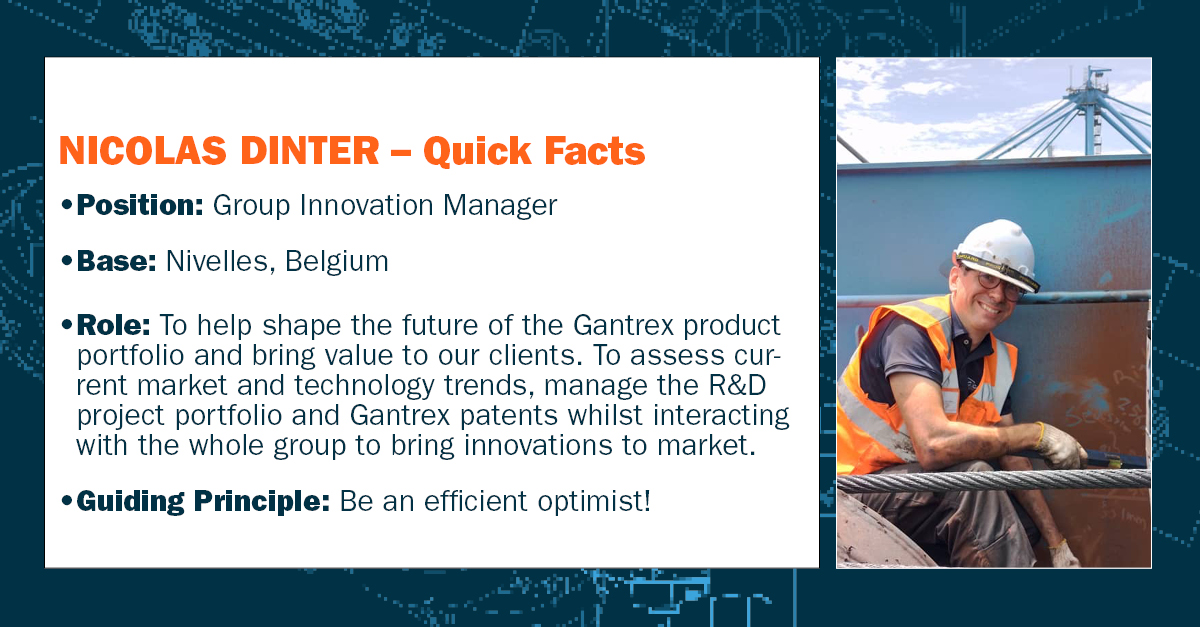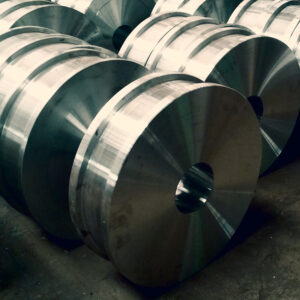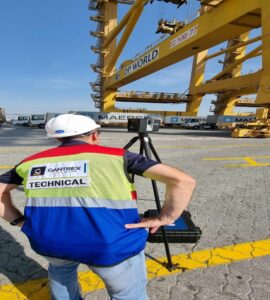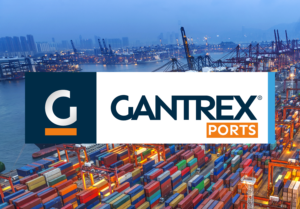THE GANTREX "INTRODUCING" SERIES #18
Nicolas Dinter, Group Innovation Manager for Gantrex, shares with us his views on innovation and the importance of patents in this latest Introducing Series. A key driver behind the Gantrex Innovation Think Tank program, Nicolas looks at the key role that innovation plays in driving market quality, what this means for our business and how it translates down to benefits for the customer.

Why is innovation such an important commercial strategy for Gantrex?
Our Gantrex patents portfolio reflects our continued effort to bring innovations to the market and our commitment to driving positive change in product, process development and performance. With on the ground presence in more than 20 countries, we can leverage an extensive talent pool to develop and bring innovations to the market. As global market leader, we see it is as our responsibility to bring continuous innovation and improvement and serve our customers the best possible way. With this in mind, we have created a group of innovation ambassadors – internally called our “Innovation Think Tank” to foster innovation within the group and to spread the innovation mindset throughout our operation.
What do you think true innovation looks like in our industry?
Innovation can be a challenging concept when you really try to pin it down as it is quite tricky to define. So, this was one of the first challenges we picked up through our Innovation Think Tank, with a view to coming up with a definition that is relevant to our operations and how we will measure what true innovation looks like for our business. So for us we decided that ‘innovation is a multi-stage process whereby organizations transform ideas into new/improved products, services, or processes, to advance, compete and differentiate successfully in the marketplace’.
And can you provide an example of a product where this definition has come into play?
Certainly. One of our latest innovations is our patented Gantrex HingeGuardTM Short Rail. This product finds roots from the multiple issues encountered by our clients with their Ship-to-Shore crane short rails. After extensive investigations we were able to develop a new kind of rail with embedded rubber. This innovation really stands out from the existing solutions. Thinking out of the box enabled us to develop a reliable solution answering clients’ issues.
We know that there is a lot of work that goes into applying for a patent. In what instances would you apply for a patent on a product? Are there certain criteria which mean that a product needs to be protected?
Taking the decision to apply for a patent does carry a significant amount of risk. Firstly, to apply you must share details of your innovation and the unique aspects of it. And secondly the process does come with a substantial amount of cost, both direct in the application and in terms of resources across the organization.
In terms of criteria, patent authorities give clear guidance, namely that a patent should present a novelty, meaning it never had been publicly disclosed. This is one of the most common hurdles where ‘new’ applications fail. The product or process applied for must be inventive, susceptible of industrial application and lawful. Once these areas are covered, then, it’s a question of whether to apply. Questions that we ask ourselves include things like does the product have sufficient market opportunity? Is our product or process easy to copy? Do we have other means whereby we can protect our innovation?
And if the answers come back in such a way as you are confident of success, what’s the next step?
We have a dedicated patent attorney that supports us throughout the process. The first step is to emphasize safeguards around communication, even internally. Then, the process to assess the patentability of the product can get underway. Of the many things that we look at, activities such as researching similar innovations or applications are undertaken. Research looks at patent publications across multiple countries, scientific journals, conferences and websites, industrial domains and in fact any other available channel where it could be applied and if it respects the law. Once everyone is satisfied that patentability is clearly defined, our attorneys write the patent. This in itself is incredibly detailed and calls for the most technically advanced skills and knowledge. Once complete, the official patent application is filed with the local patent authorities.
The application date is key since it will be the date from which the patent is accepted but also it is the date taken to expand your patent internationally which we can do within 12 months if we choose. After this period our own local patent effectively prevents us applying further as the product is effectively in existence already. If we choose to go internationally, we have two routes of action. The business can take a country-by-country approach, or an international extension can be requested via the PCT(Patent Cooperation Treaty). It’s important to note that patents for each country must be granted by that country. Except for a European patent, there isn’t a universal patent award that can cover multiple regions.
So, as you can see, it is an extensive and timely process but one which we undertake when the innovation in question is deserving of it.
The time, resource and cost required to patent products is clearly extensive. So why does Gantrex choose to register patents on certain products?
In competitive markets, where Gantrex continues to evolve, it is important to find ways to protect our business. Registering patents gives us the possibility to promote and protect our innovations. Besides, the market barrier to entry created, patents also have financial benefits by optimizing the return on the investment efforts during the development phase and create intangible assets.
In applying for a patent for a product or process, we are essentially investing in a legal vehicle which gives us the sole rights to sell, distribute, store and manufacture protected products in all countries where the patent has been accepted. In addition, it sends a strong signal to the market that our products have been thoroughly tested, have been given sufficient investment and technical resource, that we want to protect them, and that sends a strong quality and reassurance message to our customers around the world.
Opting for a patented solution means that a customer has the confidence to know they are choosing a best-in-class solution which has been assessed by a third party and one where the manufacturer has made appropriate investments in the legal and technical development of the product.
Sadly, there appear to be an increasing number of copy-cat products being brought to market by other firms who are not respecting the law. And whilst we can and will take appropriate steps to protect all our patented and patent pending innovations, it is the customer that very often will lose out in the end. Patent infringement can have serious consequences for the supplier, but also for the customers, as they are choosing a product which has not been properly tested or checked, and which could result in an unknown patent infringement further down the line. When in doubt, always check. Poor quality and cheaper copy-cat products will ultimately lead to poor performance and potentially higher cost impacts in the longer term.
Finally, what advice would you give to someone looking to pursue a career such as yours?
Looking back, I can see that my curiosity, agility and eagerness to learn were the driving principles behind the career I developed in innovation. And because of, indeed thanks to these, my career path was not the kind that went in a straight line. I took a lot of different paths each presenting me with a variety of projects, challenges, and industries. And now I see that these were almost like road signs pointing me in the right direction. Each path gave me the possibility to grow and feed my appetite to learn. In my position now with Gantrex I am lucky that I have a role that builds on my combined technical expertise and business knowledge, managing innovation and positive change.






